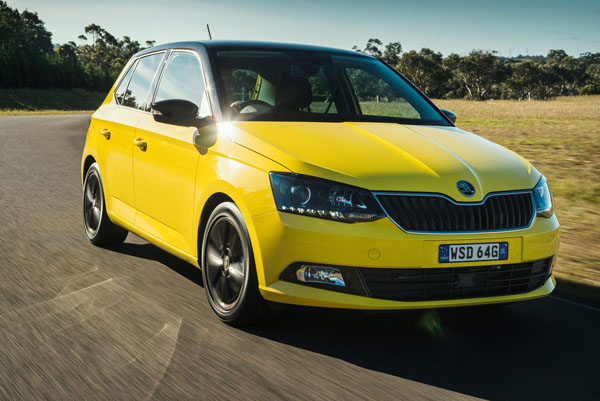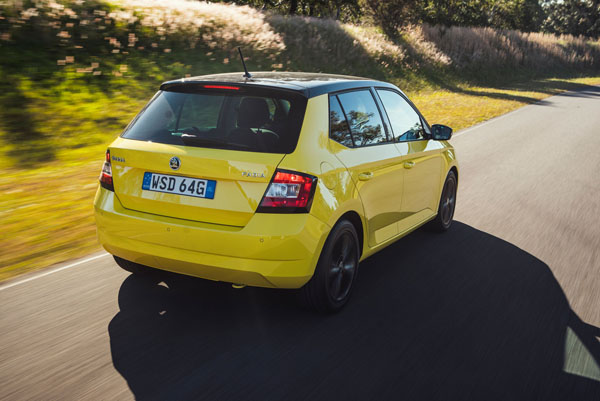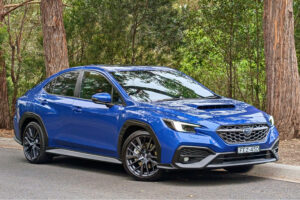“All things bright and beautiful” might seem a bit twee but when applied to the new Skoda Fabia it takes on a measure of style and substance.
In a bid to attract buyers who like to stand out from the crowd, the Czech car maker has gone to some lengths to offer kit and colours to do just that.
With a $15,999 entry-level price, there is plenty of room to make an automotive statement without flooding the bank equivalent with red.
But that is only part of the story. As well as a long shopping list of options, the new Fabia, which comes as a hatchback and wagon, features a choice of two efficient petrol engines and an eye-watering range of in-car technology in the form of Front Assist with City Emergency Brake, plus SmartLink smartphone connectivity including Apple CarPlay and Android Auto and rear parking sensors.
A 1.2-litre 66TSI engine is mated with a five-speed manual transmission, while a similar-size higher output 81TSI petrol engine is paired with a seven-speed DSG transmission. Both come up with claimed 4.8 litres per 100 kilometres fuel economy thanks to a start /stop system and brake energy recuperation. They have a Euro 6 emission rating.
Both hatch and wagon continue to exhibit the latest Skoda design thinking that debuted in the new Octavia, with the compact Fabia reaching new heights in cargo carrying capacity – 1125 litres of storage space with the rear seat backs folded for the hatch, and 1370 litres for the wagon – leaving many sports utility vehicles lagging.
Top of the class in European NCAP crash tests, the new Fabia is fitted standard with the latest technology in Front Assist with the City Emergency Braking function across the range.
The system uses a radar sensor to continually measure the distance to traffic ahead. Whenever the distance is too small, Front Assist goes to work with audio and visual warnings followed by automatic emergency stopping when necessary.
The new Fabia is one of the first vehicles in its class to offer smartphone connectivity via SmartLink as standard, allowing users to connect their mobile phone to use apps and programs through the vehicle’s interface. SmartLink works with both Apple’s Carplay and Android’s Android Auto software.
While the third generation Skoda Fabia announces its arrival with sporty proportions, it is the ability for owners to put their own stamp on the vehicle with its many sharp colours and unique features that will attract many buyers.
The new Fabia is 8 mm shorter, 90 mm wider and 31 mm lower than its predecessor, while the wagon is 10 mm longer. The added width imbues the front with a stronger character, while distinctive sharp, wide headlights, crystalline glass, slatted grille and the brand’s winged arrow on the bonnet’s ‘nose’ leave no doubt as to the car’s origins.
Skoda Fabia can be customised inside and out. With the Colour Concept option customers can choose between four colours – silver, white, black or red – for the roof, including A-pillars, mirror housings and 16-inch alloy wheels.
Six body colours are available, including standard Candy White and Corrida Red; and metallic Race Blue, Magic Black, Quartz Grey and Moon White. A vibrant Sprint Yellow and Rally Green Metallic are available with the Colour Concept.
A bespoke interior, characterised by its quality fit and finish, can call on an array of colours and their combinations.
Controls are in the right place for second-nature operation. However, there was a question mark on launch against an oversize all-new three-spoke multifunction leather steering wheel.
The second generation of Volkswagen Group’s Modular Infotainment Matrix offers Fabia DAB digital radio (optional in Premium Sports Pack), zoom and swipe smart phone-style operation and Bluetooth connection.
The Bolero infotainment system has a sharp 6.5-inch TFT colour display and a touchscreen, while six speakers deliver clear, balanced audio reproduction.
As well as Front Assist with integrated City Emergency Brake Function, the new Fabia features the third generation of multi-collision brake system, which reduces the risk of the vehicle becoming involved in a subsequent collision following an accident.
The system automatically activates the brakes if it detects an initial collision, even if the driver does not brake. This prevents a follow-on crash or at least reduces the speed at which this collision occurs.
When the Multi-Collision Brake is activated it automatically switches on brake lights and hazard lights. Automatic braking is available down to a remaining speed of 10 km/h. The driver can override the system by accelerating or initiating emergency braking.
On a launch drive in city and country traffic, the free-spinning 66 kW TSI motor responded to smooth manual gear shifts, taking even steep gradients in its stride.
The more powerful (88 kW) unit with DSG transmission appeared to offer little extra in performance, indeed, exhibiting a degree of harshness absent in its ‘little mate’.
Front Assist with City Emergency Brake function came up trumps in heavy traffic, chirping out its warnings and slowing the car when necessary.
The new Fabia is a neat compact car at a competitive entry-level price, with the opportunity to spec it up to suit the individual owner with a range of packages. A range of warranty packages are also available.
AT A GLANCE
MODEL LINE-UP
Fabia 66TSI manual hatch: $15,990
Fabia 81TSI DSG hatch: $20,290
Fabia Wagon Premium: $1150
Note: These prices do not include dealer or government charges. Contact your local Skoda dealer for drive-away prices.
Options
Metallic/Pearl Effect paint $500
Panoramic Glass Sunroof $1000
Amundsen Satellite Navigation $950
Optional packages
Travel Pack (66TSI only) $1300
Sports Pack (81TSI only) $1200
Premium Sports Pack (81TSI only) $2600
Travel Pack with Colour Concept $1600
Sport Pack with Colour Concept $1200
Premium Sports Pack with Colour Concept $2600











